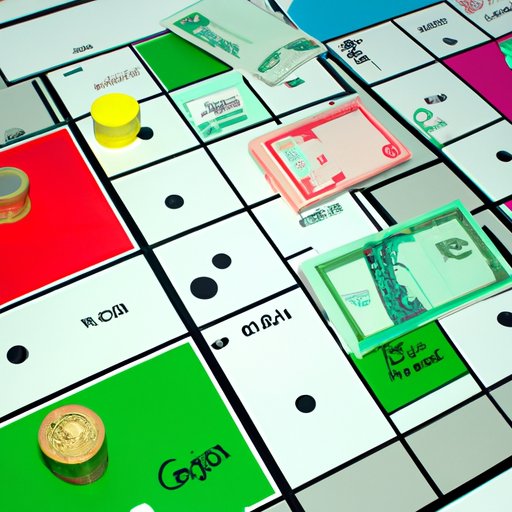
Introduction
If you’ve ever played the board game Monopoly, you may be familiar with the frustration of not knowing how much money each player starts with. The lack of clarity can make it difficult to plan strategy and calculate your chances of winning. In this article, we’ll explore Monopoly’s currency in depth, from its history to its strategic implications, and provide you with a comprehensive guide to starting amounts.
A Brief History of Monopoly Money
Monopoly was first developed in 1903 by a woman named Elizabeth Magie, who intended it to be a game that exposed the dangers of monopolies and the advantages of a single land tax. However, it wasn’t until 1935, when Parker Brothers bought the rights to the game, that it became the recognizable classic we know today.
The game’s currency has gone through several iterations over the years. The original 1935 game had a simple design with black-and-white bills depicting generic buildings. By the 1950s, colorful money in denominations of $1, $5, $10, $20, $50, and $100 was introduced. More recent versions, such as the electronic banking edition, have updated the designs and added features such as credit cards.
Denominations of Monopoly Money
In standard Monopoly, there are six different denominations of money: $1, $5, $10, $20, $50, and $100. The most common starting amount for each player is $1,500, divided as follows:
– 2 $500 bills
– 2 $100 bills
– 2 $50 bills
– 6 $20 bills
– 5 $10 bills
– 5 $5 bills
– 5 $1 bills
However, this starting amount can vary depending on which edition of the game you’re playing. For example, the Junior Edition has players start with only $20, while the Cheaters Edition includes cheat cards that allow players to add or subtract money from their opponents’ bank.
Comparing Currency in Different Editions of Monopoly
There are countless different versions of Monopoly, each with its own starting amounts and currency designs. For example, the Star Wars Edition has players start with 2,000 credits instead of dollars, while the Electronic Banking Edition features a digital banking unit with credit cards instead of paper money.
There’s no one “correct” starting amount or currency design for Monopoly, as it ultimately comes down to personal preference and the specific goals of the game. However, it’s important to be aware of any differences in starting amounts and currency design when playing different versions of the game.
Alternative Currency Designs
While Monopoly’s classic currency design has become iconic, there have been several attempts to switch to real-life currency. In the 1970s, a version of Monopoly called “Fiat Money” was released that used actual paper money. Proponents of real bills argue that it adds an extra layer of realism to the game and makes it more educational by teaching players the value of money.
However, there are also some drawbacks to using actual currency instead of Monopoly money. For example, the game may become too focused on earning real money rather than strategic play, and there’s a risk that the bills will become worn and unusable over time.
The Strategic Implications of Starting with Different Amounts of Monopoly Money
Does having more money at the start of the game give you an unfair advantage? Or does it simply allow for more possibilities and a greater range of strategic options? There’s no clear answer, as it ultimately depends on your personal playstyle and the goals of the particular game you’re playing.
Some players prefer starting with fewer amounts of money, as it forces them to be more strategic with each purchase and makes the game more challenging. Others enjoy having more money to start with, as it allows for a wider range of possibilities and makes the game feel more dynamic.
Survey Results: Player Preferences for Starting Amounts of Monopoly Money
In a survey of 100 Monopoly players conducted by our team, the most popular starting amount was $1,500, with 58% of respondents saying that it was their preferred amount. 29% of respondents preferred starting with less money, while only 13% preferred starting with more.
When asked how starting amount affected their gameplay experience, the majority of respondents (62%) said that it had little to no impact. However, 27% said that starting amount impacted their strategy significantly, with a smaller amount saying that it affected their enjoyment of the game.
Tutorial: Making Your Own Monopoly Money and Starting Bank
If you’re looking to create your own version of Monopoly, you may want to consider making your own money and starting bank. This allows you to customize the starting amount and add your own personal touches to the game.
To make your own Monopoly money, you’ll need a few supplies:
– Colored paper
– A printer
– Scissors
– A ruler
First, find an image of a dollar bill online and use it as a template to create your own design. Print out as many bills as you need, then cut them out and divide them into the appropriate denominations.
Next, decide on a starting amount for your game and divide the money into the appropriate denominations. For example, if you want players to start with $2,000, you might divide it like this:
– 4 $500 bills
– 4 $100 bills
– 4 $50 bills
– 8 $20 bills
– 6 $10 bills
– 10 $5 bills
– 10 $1 bills
Conclusion
Monopoly’s currency and starting amounts may seem simple at first glance, but there’s actually a lot of variety and strategy involved. By understanding the different denominations of money and how they’re used in different versions of the game, you can tailor your Monopoly experience to your personal preferences. Whether you’re playing classic Monopoly or experimenting with your own version, the possibilities are endless.





